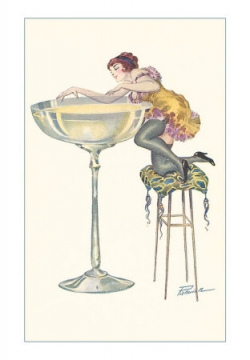THE PRACTICAL PART
Not every wine that sparkles can be called Champagne. True Champagne comes from a special region in France located 90 miles northeast of Paris. Champagne has a legendary history, and has for many hundreds of years been part of many cultural events and historical traditions. This region has a combination of chalky sub-soils and cool climate, which produces the only grapes in the world that can yield the Champagne of legends!
Grape Varieties and Styles
The three primary grape varieties that that are used to make Champagne are pinot noir, pinot meunier and chardonnay. The dark-skinned pinot noir and pinot meunier give Champagne its length and backbone, while chardonnay gives it acidity notes and biscuit flavour. There are several other grape varieties that are permitted for historical reasons, and are used occasionally.
Non-vintage
A non-vintage Champagne includes a blend of grapes from several vintages. They also have a consistent style, and are made for immediate consumption. Most Champagne is non-vintage. Only a few non-vintage Champagnes will benefit from further aging.
Vintage
Champagne vintages are declared only for outstanding harvest years and are made from a single harvest year. The producers reserve their finest fruit for this style of Champagne, adding to its desirability. Not every year is declared a vintage year.
Presitge Cuvées
This is a proprietary blend, the top of the producer’s range, and is most suitable for cellaring. The trend is that these Champagnes come delivered in very expressive, distinctively-shaped, and labeled bottles. These Champagnes are usually made with grapes from Grand Cru vineyards.
Blanc de Blancs
Blanc de blanc is a French term that means “white of whites”, and is used to designate Champagnes made exclusively from chardonnay grapes. The blanc de blancs style is popular as an apértif due to their light, dry taste.
Blanc de Noirs
Blanc de Noirs is another French term that means “white of black”. This sounds like a contradiction, but it is not. What it tells you is that the Champagne has been made only using black grapes. Champagne made from black grapes are typically full bodied with intense richness.
Rosé
Rosé Champagnes are produced either by leaving the clear juice of black grapes to macerate on its skins for a short time or, the common method, by adding a small amount of still pinot noir red wine to the sparkling wine.
Sweetness (Brut to Doux)
In addition to classifying Champagne styles, classifications are also used to refer to sweetness. The amount of sugar added after the second fermentation and aging varies and will dictate the sweetness level of the Champagne.
• Brut: dry, less than 1.5% sugar (most common)
• Extra Sec: extra dry, 1.2 to 2% sugar
• Sec: medium sweet, 1.7 to 3.5% sugar
• Demi-Sec: sweet, 3.3 to 5% sugar (dessert Champagne)
• Doux: very sweet, over 5% sugar (dessert Champagne)
THE FUN PART – TASTING
What can you see? What can you smell? What can you Taste? Champagne deserves your undivided attention. You need time to appreciate its colour, effervescence, savour its aromas and define its dominant impressions.
Before you pop the cork, there are a few basic tips:
• Flutes should be clean and free of any traces of detergent or rinsing agent [could cause Champagne to flatten]
• Avoid all forms of perfume, i.e., personal or room fragrance [these will interfere with the appreciation of the aromas]
• Ideal drinking temperature is [8° – 10° C] – chill the bottle for 20 minutes in an ice bucket filled with ice
• When pouring, fill the glass only two-thirds [this allows the aromas to circulate]
• Once the Champagne is poured, allow some time for it to open up
Colour and Appearance
Once the Champagne is poured, place a sheet of white paper behind the glass try to identify the shade.
Colours can range from: pale gold; green gold; grey gold; straw yellow; yellow gold to antique gold. For rosé Champagnes colours range from coral pink, salmon pink to deep pink.
How does the Champagne look to you? Is it limpid, sparkling or silky?
And what about the bubbles, are they: light; fine; lively; plentiful or slow?
Nose
Once the initial effervescence has subsided, bring the flute to your nose and inhale slowly, at length and then inhale again.
How do you describe the aromas? Are they floral, fruity, vegetal, or does the aroma remind you of dried fruits or some other indulgent delicacy?
Floral aromas can range from rose, lime blossom, orange blossom or violet.
Fruity smells will range from grapefruit, apple, pear, quince, peach, apricot, nectarine, mango, banana, lychee, coconut, cherry or currant.
Vegetal bouquets range from almond, grass, fern, to truffle.
Dried Fruit odours range from hazelnut, raisin to dried fig.
Other indulgent delicacy aromas include butter, brioche, toast, honey, candied fruit, vanilla and various spices.
Mouth
Champagne reveals its complex personality best on the palate.
Try rolling the Champagne around your mouth – there is bound to be a dominant impression.
How does the Champagne feel?
Does it feel powerful, solid, comforting, smooth, light, mature, or opulent?
Now how would you describe the impression?
Is it creamy, delicate or complex?
Go ahead and enjoy what is hiding inside your flute!
To participate in tomorrow’s festivities, follow the #ChampagneDay hashtag on Twitter, Facebook, and on other social media sites. For more information about #ChampagneDay or the worldwide effort to protect wine place names and origins, please visit http://bit.ly/rhBcbh or www.champagne.us.
Liz Palmer
coHost for #ChampagneDay
@champagneHouses
http://about.me/lizpalmer


